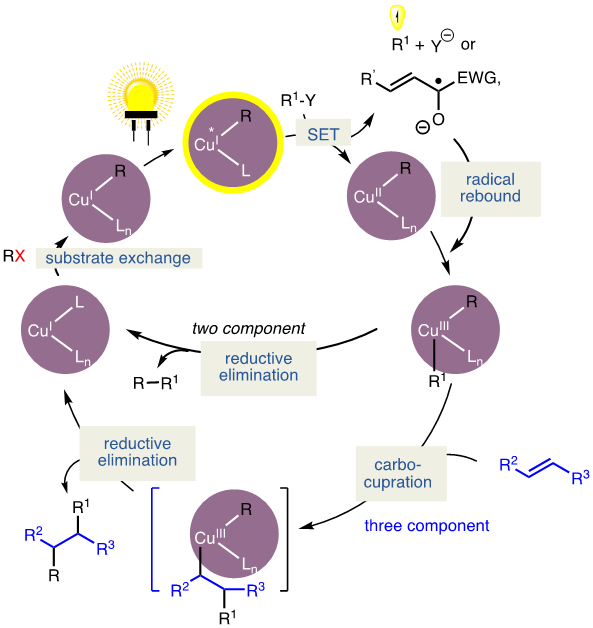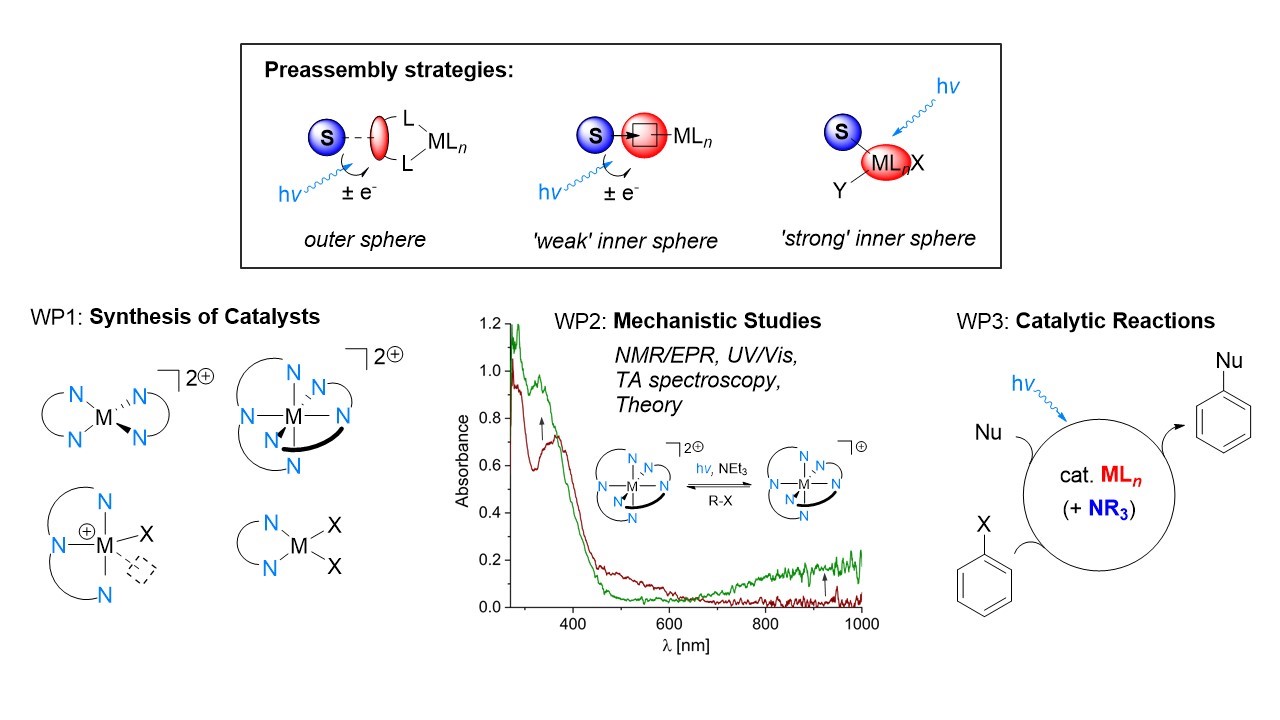Project Area A
A1: Visible Light Mediated Coupling Reactions via Photoexcitation of Cu(I)-Substrate Assemblies
The utilization of photoactive Cu(I)-substrate complexes as one electron reductants for a second substrate will be explored, giving rise to a transient radical, which is either trapped directly by the concurrently formed Cu(II)-photocatalyst (two component process), or prior to this step is intercepted by an alkene (three component process). Employing chiral copper(I)-photocatalysts offers in addition the opportunity to render such coupling reactions asymmetric. The approach followed holds the promise to achieve copper-catalyzed cross coupling processes as known so far only by palladium catalysis.

Publications
Current Publications
Reichle, Alexander; Koch, Magdalena; Sterzel, Hannes; Großkopf, Lea-Joy; Floss, Johannes; Rehbein, Julia; Reiser, Oliver: Copper(I) Photocatalyzed Bromonitroalkylation of Olefins: Evidence for Highly Efficient Inner-Sphere Pathways, Angew. Chem. Int. Ed. 62, 2023, e202219086 ⇒ See Publication
Key Publications
Engl, Sebastian; Reiser, Oliver: Copper makes the difference: Visible-Light-Mediated Atom Transfer Radical Addition (ATRA) Reactions of Iodoform with Olefins, ACS Catal., 10, 2020, 17, 9899–9906 ⇒ See Publication
A2: Visible Light Induced Homolysis (VLIH) of 3d-Metal-Substrate Complexes
In this project, we will demonstrate that 3d-transition metal-ligand complexes can be rendered capable photoredox catalysts to promote organic transformations. As the key concept it is proposed that suitable metal-ligand-substrate complexes MLn–Z (Z = substrate) can be irradiated by light upon which VLIH will occur to generate M–1Ln + Z• as a starting point for productive organic trans-formations. Two proof of concept studies. i. e. the large-scale synthesis of P2-cyclopentyltetra-hydrofuranyl urethanes (HIV-I-protease inhibitor) and of bicyclic endoperoxides (plasmodium) having IC50 values in the nanomolar region, are envisioned.

Publications
Current Publications
Reichle, Alexander; Reiser, Oliver: Light-induced homolysis of copper(II)-complexes – a perspective for photocatalysis, Chem. Sci., 14, 2023, 4449 ⇒ See Publication
Q.-Q. Zhao, J. Rehbein, O. Reiser: Thermoneutral synthesis of spiro-1,4- cyclohexadienes by visible-light-driven dearomatization of benzylmalonates, Green Chem., 24, 2022, 2772-2776 ⇒ See Publication
A. Reichle, H. Sterzel, P. Kreitmeier, R. Fayad, F. N. Castellano, J. Rehbein, O. Oliver: Copper(II)-photocatalyzed decarboxylative oxygenation of carboxylic acid, Chem. Commun., 58, 2022, 4456-4459: ⇒ See Publication
Key Publications
Y. Abderrazak, A. Bhattacharyya, O. Reiser: Visible‐Light‐Induced Homolysis of Earth‐Abundant Metal‐Substrate Complexes: A Complementary Activation Strategy in Photoredox Catalysis, Angew. Chem. Int. Ed. 60, 2021, 21100-21115: ⇒ See Publication
R. Fayad, S. Engl, E. O. Danilov, C.E. Hauke, O. Reiser, F.N. Castellano: Direct Evidence of Visible Light-Induced Homolysis (VLIH) in Chlorobis (2,9‐dimethyl‐1,10‐phenanthroline)copper(II), J. Phys. Chem. Lett. 11, 2020, 5345-5349: ⇒ See Publication
A3: Photocatalysis with Reversibly Coordinating Cerium Complexes
Introduction: Photoinduced ligand to metal charge transfer (LMCT) is well known and observed in many coordination compounds; text book examples are Cr(III) aquo and hydroxido complexes or titanium alkoxides. However, only recently, applications of visible light driven cerium LMCT reactions in organic synthesis were reported. The reversible coordination of a cerium (III) or (IV) salt to alcohols followed by photoinduced LMCT yields alkoxy radicals under mild reaction conditions. The alkoxy radicals were used for intramolecular C–H activation by hydrogen atom abstraction (HAT) and the resulting sp3 alkyl radical was reacted with alkenes. The high reactivity of alkoxy radicals in HAT allowed even the intermolecular C–H activation of methane gas using cerium complexes in alcohol solution. The reported applications of cerium photocatalysis of the last five years have clearly demonstrated the synthetic potential of the cheap and earth abundant metal ion in light driven transformations. The key step in reactions with alcohols is an LMCT process. However, so far only chlorido cerium complexes that are kinetically labile have been used, which hampers a rational catalyst optimization. In addition, the roles of additives and the widely used radical reaction partner dibenzylazodicarboxylate in the mechanism of the reaction remain unclear. Schelter et al. established a cerium complex structure – property relationship for guanidinate−amide and guanidinate−aryloxide Ce(III) complexes. However, these complexes have found only few synthetic applications so far.

Summary of the project. We aim in this project to develop better-defined LMCT cerium photocatalysts and apply the LMCT principle to new transformations, such as selective intra- and intermolecular C–H functionalizations in compounds bearing hydroxyl groups, oximes or hydroxamic acids. Moreover, to achieve selectivity in intermolecular C–H abstraction on oligohydroxy compounds selective activation is proposed, which results in weakening and preferred abstraction of C–H bonds by photocatalytically generated alkoxy radicals. The effect of Lewis-acid assembly on specific C–H bonds is observable in NMR spectroscopy allowing the prediction of assembly controlled photocatalytic C–H activation from spectroscopic data.
Key Publications
V. R. Yatham, P. Belotti, B. König, ´Decarboxylative hydrazination of unactivated carboxylic acids by cerium photocatalysis´ Chem. Commun. 2019, 55, 3489-3492.
J. Schwarz, B. König, ´Visible-light mediated C–C bond cleavage of 1,2-diols to carbonyls by cerium-photocatalysis´ Chem. Commun. 2019, 55, 486-488.
A4: 3d Transition Metal Complexes for Photocatalysis: The Crucial Influence of Catalyst-Substrate Assembly on Reactivity
In collaboration with our colleagues at Regensburg, Munich and Leipzig, we develop photoredox reactions catalyzed by 3d transition metal complexes. Use of substrate-catalyst preassembly offers the chance to overcome some of the key shortcomings of current 3d metal photocatalysts, specifically the extremely short excited state lifetimes of most 3d metal species. Our project investigates ‘outer sphere’ interactions, in which the substrate interacts with the ligand sphere of the metal (e.g. through π-π interactions with heterocyclic ligands or hydrogen bonding to pendant hydrogen bond donors), and ‘inner sphere’ interactions, in which the substrate binds strongly or weakly at the metal atom. In both cases, coordination chemical studies will determine the optimal design principles for the envisaged photocatalysts, alongside analysis of their electronic structures. To guide the development of this project it will be crucial to understand the specific interactions that exist between substrates and catalysts both in the ground and excited states. This fundamental knowledge will then permit the targeted development of applications in organic synthesis, which harness the specific advantages of the developed catalysts in comparison with precious metal compounds.

Coordination Chemistry, Synthesis
A5: Monitoring and Exploiting Short-lived Intermediates in Assembly-Controlled Photocatalytic Processes
The project aims to identify spectroscopic signatures of pre-assembled species and to mechanistically understand on a molecular level to which extent these enable new photocatalytic possibilities. The prospects of pre-assembly are investigated with time-resolved spectroscopy for three scenarios: i) non-covalent substrate-catalyst interactions, ii) chromophores covalently bound to a moiety exhibiting catalytic activity, and iii) organic radicals acting as photocatalysts. The studies are augmented by utilizing high pressure, electrochemistry, and magnetic fields, and are complemented by close collaboration with synthesis and theory.
Physical Chemistry, Spectroscopy





